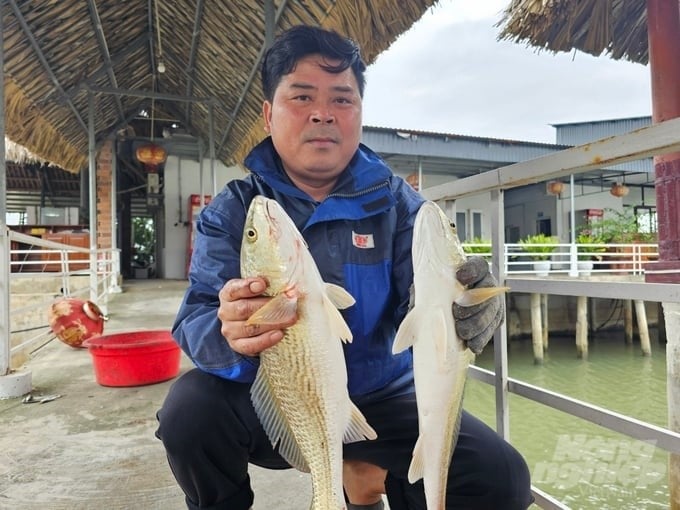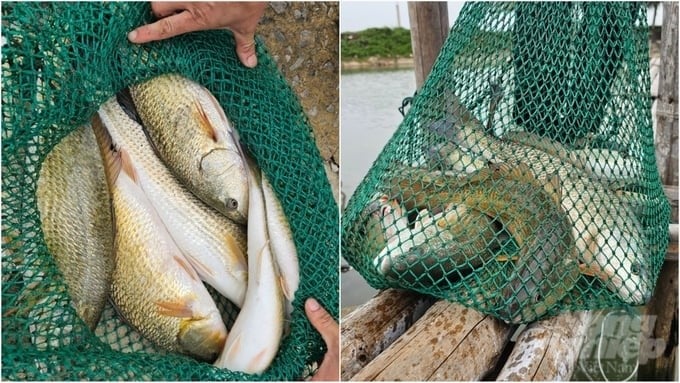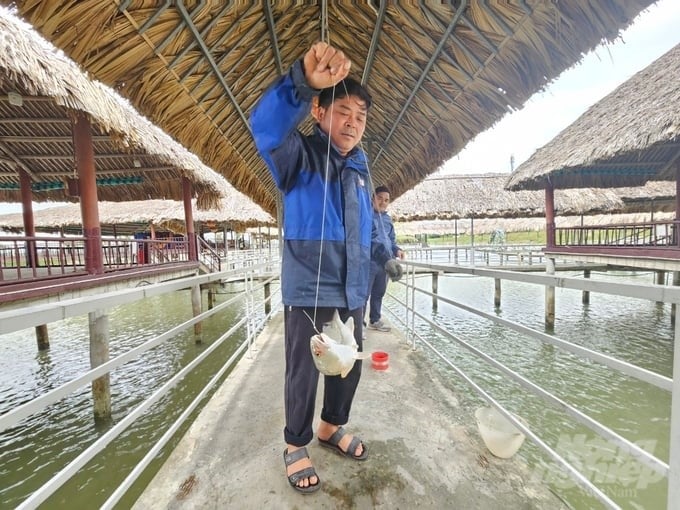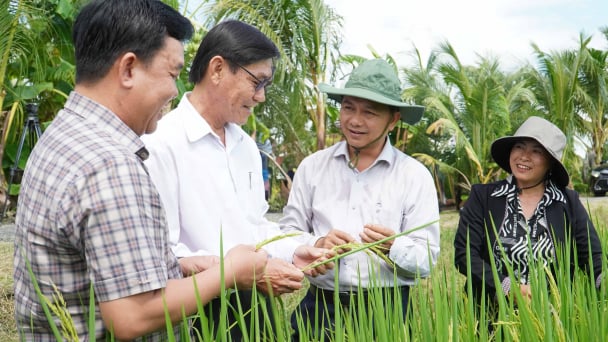June 18, 2025 | 15:26 GMT +7
June 18, 2025 | 15:26 GMT +7
Hotline: 0913.378.918
June 18, 2025 | 15:26 GMT +7
Hotline: 0913.378.918
Thanh Hoa is a province with the potential to strongly develop aquaculture, thanks to the diversity of natural conditions and abundance of aquatic resources. In recent years, the fisheries economy in general and aquaculture in particular have significantly contributed to the structure of the local agriculture sector. Among aquaculture models, it must mention the red drum farming model, which has initially brought high economic efficiency to many farmers.

Red drums help Mr. Vu have a stable income. Photo: Quoc Toan.
Mr. Vu Dinh Vu (Thanh Thang residential group, Quang Cu ward, Sam Son city, Thanh Hoa) has more than a decade of experience in aquaculture. Initially, he invested in a pond to raise giant tiger prawns, but it was not effective, so he switched to the red drum farming model.
After receiving advice and support from the Agricultural Extension Center of Thanh Hoa province, Mr. Vu improved a 1.7-hectare pond and imported 2,000 breeds for experimental farming. Thanks to good exploitation of the advantage of the tidal zone and available food sources from local fishing vessels, Mr. Vu is quite advantageous in developing the model. In the first year of experimental farming, Mr. Vu sold about 2 tons of red drum, earning an income of more than VND 100 million after deducting expenses.
After initial success with the red drum farming model, Mr. Vu decided to expand the farming quantity to 5,000 breeds, combined with catering and recreational fishing services. In 2023, it is estimated that red drum output will reach 5 tons, giving an income of about VND 500 million. After deducting expenses, he will earn a profit of about VND 250 million.
“Red drum is a fish species with high and stable economic value and low disease risk. The selling price depends on weight and market price stability. The average selling price is about VND 100,000/kg. It takes only about 7-8 months to raise red drums before selling. Red drum has delicious meat, rich flavor, and can be prepared in many dishes, so diners love it very much. The best fish consumption is in the summer and winter," Mr. Vu shared.

It takes about 7-8 months to raise red drums before selling at a price of VND 100,000/kg. Photo: Quoc Toan.
Mr. Tran Van Son (Do Luong village, Nga Thuy, Nga Son, Thanh Hoa) is one of the pioneering households raising red drums in the locality. After four years of raising red drum, Mr. Son realized that this fish species is many times healthier than other types of seafood, with little risk, care techniques that are not too complicated, stable prices, guaranteed quality, and lower farming costs than that of traditional fish.
Mr. Son noted that during the farming process, once a month, organic humus as well as leftovers that have settled to the bottom of the pond must be handled. Food for red drums is industrial feed with a protein content of over 43%. Depending on the fish's development stage, the appropriate amount of protein and food can be supplemented.
However, many red drum-farming households are facing difficulties because of product output. Most pond and lagoon owners have to find their own consumption markets. Linkage in production along the value chain is still limited, making the product less popular in the market.
Red drums were imported as juvenile fish to Vietnam for the first time since 1999. After a period of farming, red drum has shown superior characteristics such as fast growth, adaptability to environmental conditions, and being suitable for farming in earthen ponds, cement tanks, or cages in different water environments (salty, brackish).
In addition to its economic value, red drum is also considered suitable for farming in disease-infected giant tiger prawn farming ponds. Furthermore, red drums suffer little loss during the farming process, so productivity is very high.
In Thanh Hoa province, red drums are raised in Hoang Yen commune (Hoang Hoa district), Da Loc and Hoa Loc communes (Hau Loc district), Nga Thuy and Nga Tan communes (Nga Son district), Quang Cu ward (Sam Son city), and Xuan Lam ward (Nghi Son town), etc.
To build and develop the red drum farming model, the Agricultural Extension Center of Thanh Hoa province has provided technical support and breeds to farmers in association with product consumption. The results showed that, with intensive red drum farming using 100% industrial feed, the fish reached a size of 0.9–1 kg after 10 months of farming. With a farming area of 10,000 m2, after deducting expenses, the profit is about 150–200 million/ha. Compared to extensive giant tiger prawn farming, the income is many times higher.

The red drum is an omnivorous species that adapts well to the environment and is less susceptible to diseases. Photo: Quoc Toan.
Red drum is resistant to coldness, can be raised in winter, and has the potential to be processed into value-added products, bringing high income to farmers. Through evaluation and monitoring of the models, the Agricultural Extension Center of Thanh Hoa province affirmed that red drum is a farming species suitable for natural conditions in the North in general and Thanh Hoa in particular, and the model can be replicated in many localities in the province.
According to the Agricultural Extension Center of Thanh Hoa province, besides intensive farming, red drum can be raised according to forms of improved extensive farming or semi-intensive farming, depending on capital capacity and market demand. Red drum is a fierce, predatory fish that can take advantage of natural food such as trash fish, wild tilapia, sardine, etc. in the natural environment, thereby reducing food costs and improving economic efficiency per unit area.
Translated by Huyen Vu Thu
/2025/06/17/3942-2-143243_548.jpg)
(VAN) Recently, in Sweden, the Secretary of the Binh Dinh Provincial Party Committee presented the Investment Registration Certificate for the 'Polyester Fabric Recycling Complex' project to SYRE Impact-AB Company.
/2025/06/12/3721-2-202745_83.jpg)
(VAN) TH made an impression at Seoul Food 2025 with its line of natural beverages, paving the way for Vietnamese food products to enter the South Korean market.

(VAN) Soc Trang's success in rice exports stems from a strategy of developing fragrant and specialty rice cultivation areas and standardizing production toward low-emission practices.
/2025/06/11/1311-5-120811_839.jpg)
(VAN) The pig farming industry is facing the challenge of comprehensive restructuring to meet requirements for quality, safety, traceability, and market expansion both domestically and for export.

(VAN) Vietnam considers participating in ALGROALBA in order to expand agricultural production, coordinate the assessment and effective exploitation potential land.
/2025/06/05/5314-1-184727_407.jpg)
(VAN) From seemingly worthless fish scales and skin, enzymes and lactic ferments can transform by-products into peptides, opening a sustainable, effective business direction and elevating Vietnamese seafood.

(VAN) TTC AgriS and IFC signed a strategic partnership to develop a sustainable agricultural value chain, aiming to achieve the Net Zero target by 2035.